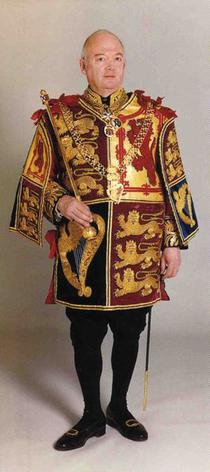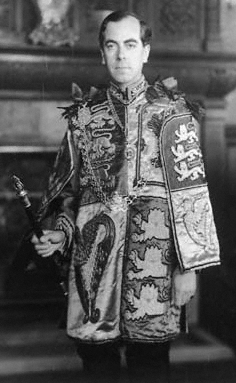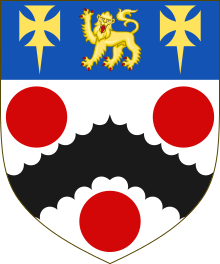
The College of Arms, or Heralds' College, is a royal corporation consisting of professional officers of arms, with jurisdiction over England, Wales, Northern Ireland and some Commonwealth realms. The heralds are appointed by the British Sovereign and are delegated authority to act on behalf of the Crown in all matters of heraldry, the granting of new coats of arms, genealogical research and the recording of pedigrees. The College is also the official body responsible for matters relating to the flying of flags on land, and it maintains the official registers of flags and other national symbols. Though a part of the Royal Household of the United Kingdom, the College is self-financed, unsupported by any public funds.

Clarenceux King of Arms, historically often spelled Clarencieux, is an officer of arms at the College of Arms in London. Clarenceux is the senior of the two provincial kings of arms and his jurisdiction is that part of England south of the River Trent. The office almost certainly existed in 1420, and there is a fair degree of probability that there was a Claroncell rex heraldus armorum in 1334. There are also some early references to the southern part of England being termed Surroy, but there is not firm evidence that there was ever a king of arms so called. The title of Clarenceux is supposedly derived from either the Honour of the Clare earls of Gloucester, or from the Dukedom of Clarence (1362). With minor variations, the arms of Clarenceux have, from the late fifteenth century, been blazoned as Argent a Cross on a Chief Gules a Lion passant guardant crowned with an open Crown Or.

Norroy and Ulster King of Arms is the provincial King of Arms at the College of Arms with jurisdiction over England north of the Trent and Northern Ireland. The two offices of Norroy and Ulster were formerly separate. Norroy King of Arms is the older office, there being a reference as early as 1276 to a "King of Heralds beyond the Trent in the North". The name Norroy is derived from the Old French nort roy meaning 'north king'. The office of Ulster Principal King of Arms for All-Ireland was established in 1552 by King Edward VI to replace the older post of Ireland King of Arms, which had lapsed in 1487.

John Philip Brooke Brooke-Little was an English writer on heraldic subjects, and a long-serving herald at the College of Arms in London. In 1947, while still a student, Brooke-Little founded the Society of Heraldic Antiquaries, now known as the Heraldry Society and recognised as one of the leading learned societies in its field. He served as the society's chairman for 50 years and then as its president from 1997 until his death in 2006.

Sir Thomas Woodcock FRHSC is a genealogist who served as Garter Principal King of Arms at the College of Arms from 2010 to 2021.

Sir Anthony Richard Wagner was a long-serving officer of arms at the College of Arms in London. He served as Garter Principal King of Arms before retiring to the post of Clarenceux King of Arms. He was one of the most prolific authors on the subjects of heraldry and genealogy of the 20th century.

Heraldic visitations were tours of inspection undertaken by Kings of Arms throughout England, Wales and Ireland. Their purpose was to register and regulate the coats of arms of nobility, gentry and boroughs, and to record pedigrees. They took place from 1530 to 1688, and their records provide important source material for historians and genealogists.

Ireland King of Arms was the title of an officer of arms to the King of England and Lord of Ireland from 1392 until the accession of Henry VII as King of England in 1485. A king of arms is the highest of the three levels of officers of arms, and usually enjoys heraldic jurisdiction over a geographical area. Despite the name Ireland King of Arms did not appear to exercise heraldic authority in Ireland, and indeed the connection with Ireland seems rather tenuous. The office may have been created preparatory to a subsequently aborted military expedition to Ireland. The last holder of the office, Walter Bellinger, did exercise the heraldic prerogative of a king of arms to grant armorial bearings, however two of his grants were annulled or regranted by other kings of arms as they felt he encroached on their provinces. In 1552, 70 years after the last Ireland King of Arms, the office of Ulster King of Arms was created. The holders of this office exercised control over the heraldic affairs of Ireland until the death of its last incumbent, Major Sir Neville Wilkinson, in 1941. Thereafter, heraldic affairs within what later became the Republic of Ireland were transferred to the Government of Ireland while the jurisdiction of Norroy King of Arms expanded to include Northern Ireland when the present office of Norroy and Ulster King of Arms was established in the College of Arms.
John Writhe was a long-serving English officer of arms. He was probably the son of William Writhe, who represented the borough of Cricklade in the Parliament of 1450–51, and is most remembered for being the first Garter King of Arms to preside over the College of Arms. Writhe is also notable for the contention that it was he who developed the system of heraldic cadency employed by English officers of arms to the present day.
Roger Machado was an English diplomat and officer of arms of Portuguese extraction. He lived among the Portuguese merchants at Bruges in 1455.

Sir Thomas Wriothesley was a long serving officer of arms at the College of Arms in London. He was the son of Garter King of Arms, John Writhe, and he succeeded his father in this office.
Charles Wriothesley was a long-serving officer of arms at the College of Arms in London. He was the last member of a dynasty of heralds that started with his grandfather—Garter Principal King of Arms John Writhe.
Sir Christopher Barker was an officer of arms at the College of Arms in the City of London who rose to the highest position of Garter Principal King of Arms.

Ralph Bigland was an English officer of arms, antiquarian and cheesemaker. He was born at Stepney, Middlesex, and was the only son of Richard Bigland and his wife, Mary. His father was a native of Westmorland, descended from the Bigland family of Biglands. He should not be confused with his nephew Sir Ralph Bigland, who also served as an officer of arms.

Thomas Hawley was a long-serving officer of arms at the College of Arms in London. He began his career of royal service as a groom porter to Queen Margaret of Scotland from her marriage in 1503 until 1508. Although he may have been made Rose Blanche Pursuivant in the reign of King Henry VII, his first permanent heraldic appointment came in 1509.

Stephen Martin Leake was a numismatist and long-serving officer of arms at the College of Arms in London.

English heraldry is the form of coats of arms and other heraldic bearings and insignia used in England. It lies within the so-called Gallo-British tradition. Coats of arms in England are regulated and granted to individuals by the English kings of arms of the College of Arms. An individual's arms may also be borne 'by courtesy' by members of the holder's nuclear family, subject to a system of cadency marks, to differentiate those displays from the arms of the original holder. The English heraldic style is exemplified in the arms of British royalty, and is reflected in the civic arms of cities and towns, as well as the noble arms of individuals in England. Royal orders in England, such as the Order of the Garter, also maintain notable heraldic bearings.
William Flower (1497/98–1588) was an English Officer of Arms in the reigns of Henry VIII, Edward VI, Mary I and Elizabeth I. He rose to the rank of Norroy King of Arms, serving in that capacity from 1562 until his death in 1588.

Robert Glover was an English officer of arms, genealogist and antiquarian in the reign of Elizabeth I. In the College of Arms, he rose to the rank of Somerset Herald of Arms, serving in that capacity from 1571 until his death in 1588. As marshal and deputy to his father-in-law, William Flower, Norroy King of Arms, he participated in heraldic visitations throughout northern England.

Robert Cooke was an English Officer of Arms during the reign of Elizabeth I, who rose swiftly through the ranks of the College of Arms to Clarenceux King of Arms, serving in that office from 1567 until his death in 1592–3.















